Fingers point at everyone else at fault—staff, insurance carriers, the health care system, Internet competition, even patients. Yet we ignore daily opportunities that could quiet our complaints—if only we take would advantage of what’s right in front of us. Perhaps it’s complacency created by making a good living that is blinding us from opportunities that present themselves every day.
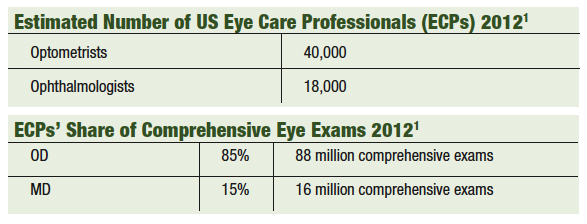
Statistics from the American Optometric Association’s recently published State of the Optometric Profession: 2013 may shock, upset or perhaps motivate you. Or you may simply surrender to the greater market forces at work and consign yourself to the depths of hell of our chosen profession—unless you choose to do something about it! Optometrists are at the forefront of primary eye care for the 314 million people in the US today. We outnumber ophthalmologists by more than two to one and provide the vast preponderance of annual comprehensive eye exams.
However, our productivity hasn’t improved. We haven’t created additional opportunities for increasing patient volume, productivity or profitability, as seen in the number of eye care encounters performed per hour (see table above). To see that this statistic has remained static for 15 years blows me away. What have we been doing for the last decade and a half? If it doesn’t change, that’s one statistic that will put the nail in the coffin of optometric eye care in the current era of health care reform.
As if that’s not bad enough, we’re not even close to performing up to our potential in other areas, either.
I’m making an economic call to action. When are we going to realize that we are the primary eye care providers and have the numbers, talent, legislative scope and technology to control this marketplace?
I have a theory based on the “economics of apathy”: Procrastination and inaction costs you money. A lot of it. But by simply doing a few basic things, you can reverse your fortunes. I’ll show you how.

The Six Million Dollar OD
Let’s say the average OD works 45 years in practice and makes a net income of $134,000 per year. (See income survey.) That puts the average OD’s lifetime earnings at $6,030,000. While many of us never consider that we will have earned more than $6 million in our lifetime, numbers don’t lie. It may seem like a lot, but think about how much money that inaction in our practices costs us. When we look at it in the aggregate, our inaction, procrastination and apathy ends up costing us more than what our daily practices provide. Let’s look at some statistics regarding the size of the primary eye care market (refractive exams, vision correction device sales, but not plano sunglasses, cataract or refractive surgery or medical eye care). Yes, it’s true that material sales have declined.
It may seem like a lot, but think about how much money that inaction in our practices costs us. When we look at it in the aggregate, our inaction, procrastination and apathy ends up costing us more than what our daily practices provide. Let’s look at some statistics regarding the size of the primary eye care market (refractive exams, vision correction device sales, but not plano sunglasses, cataract or refractive surgery or medical eye care). Yes, it’s true that material sales have declined.
The increased number of purchase channels available to the consumer and new sources of competition have steadily eroded this once-consistent source of profitability, with now 27% of patients walking with their spectacle Rx. It’s my opinion that many ODs use their professional services as loss leaders simply to capture the optical sale. Unless professional fees are set properly, and productivity increases to at least five to six patient encounters per hour (e.g., three full exams, two to three E/M encounters), ODs are never going to recognize proper ratios of income distribution between professional services and material sales.
Now let's talk about contact lenses. Optometrists largely control the contact lens market, but we haven’t done enough to grow it. Contact lens usage has remained flat over the last decade. Even with accelerating technological developments in the contact lens area, many consumers aren’t aware of the new technology because too often they don’t ask—and if they don’t ask, we don’t tell.
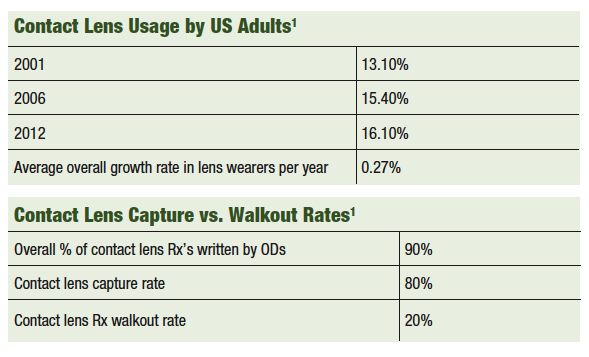
It’s bad enough that we capture only 80% of our own contact lens Rx’s, but now we have to concede that the “returning contact lens patient” market is also shrinking. Nearly four years ago, I wrote an article on contact lens dropout rates around the world.2 My data showed that the average practice has a nearly 16% dropout rate—low by some measures, as published in subsequent studies. Nonetheless, that 16% dropout rate represented a significant opportunity to provide our patients with great care and increase our income. The mean annual value of a single contact lens patient was found to be $275.2
Since that time, there have been additional studies on contact lens dropout rates and much innovation in the contact lens industry to address this problem. A dropout rate of 16% means that one out of every six of your contact lens patients stops wearing their lenses. While many of you are still in denial and telling yourself that this doesn’t happen with your patients, there are others who think, “Hmm, I wonder what that’s really costing me?” A timely question, particularly because dropout can be prevented simply by recommending and prescribing lenses and lens care products that are designed to provide better comfort and health.
For those who think this doesn’t affect you, let’s take a look at how costly denial and inaction can be. Remember that contact lens patient who generates $275 per year? Let’s look at what that means over your 45 years in practice (see table above).
So, if you want to add another cool $2+ million to your lifetime earnings, stop denying that contact lens dropouts aren’t happening in your practice and turn that inaction into something that you can deposit in your bank account.
Also, consider that losing a contact lens patient not only costs you that revenue stream, you also incur the “replacement cost” of bringing in a new patient.
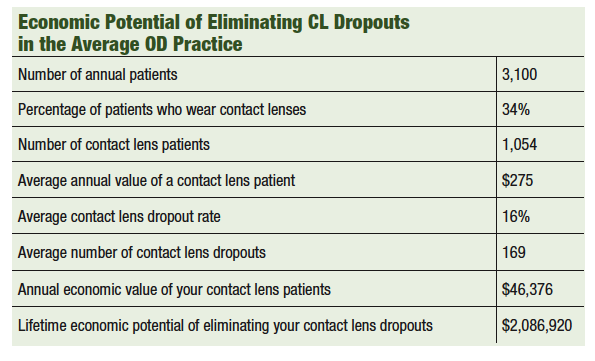
Primary Care Carelessness
Medical eye care is another critical area of potential revenue loss. How so? We don’t recognize medical disease opportunities, aren’t billing for them, or are simply referring these patients out of our offices. With medical eye care at only 17% of total revenue, we are clearly not capitalizing on our role as primary and secondary eye care providers. Let’s consider just one of these opportunities: ocular allergy. Patients rarely seek help for ocular allergy, even though it’s one of the most common ocular afflictions. Because of its prevalence, you don’t have to market externally or spend one thin dime to attract these patients. They walk into your practice every day. Most of us think that a reasonable person would tell us if they suffer from ocular allergies. But our average patient generally doesn’t know the breadth of our clinical knowledge. Consumers typically associate us with prescribing glasses and contact lenses. Why not with ocular allergy? Because we don’t tell them! We wait for them to complain to us about their eyes.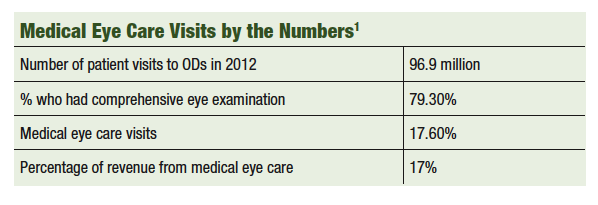
Why would they mention ocular allergies (for which they are probably self-treating, by the way) to us if they don’t know it’s part of our clinical profile? We should ask every patient on every encounter about ocular allergies.
I know what you’re thinking: that takes too much time, my staff just won’t do it, or I don’t do medical eye care—all typical behaviors of inaction. Now take a look at what it’s costing you: A potential $8+ million, just by being clinically proactive and taking proper and appropriate care of our patients.
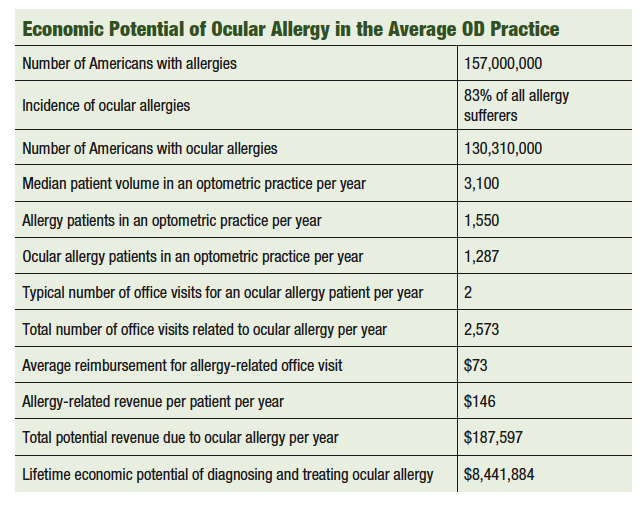
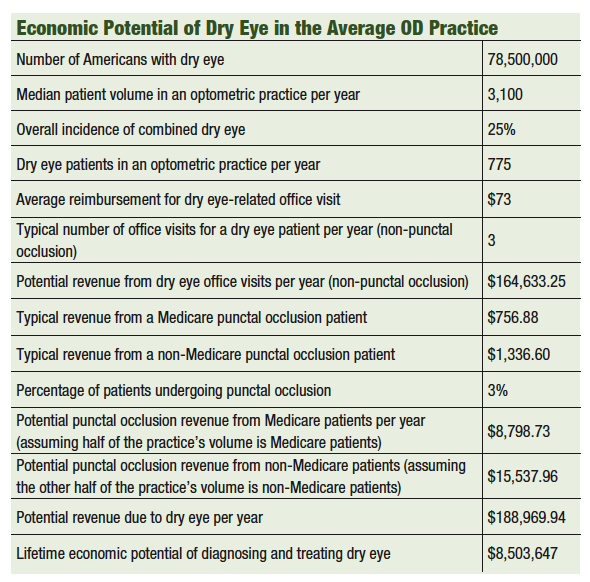
I realize that some may question these numbers; in fact, I hope that this article motivates you to examine what’s happening in your practice in these three areas. Even if your final calculations don’t match mine, I’ll bet that by going through the process of individual analysis, you’ve found additional opportunities within your practice that are just waiting for you to take action. (I didn’t add in the revenue potential for glaucoma or the fast-emerging clinical need for detecting and managing macular degeneration, but I look forward to sharing those opportunities with you in a future article.)
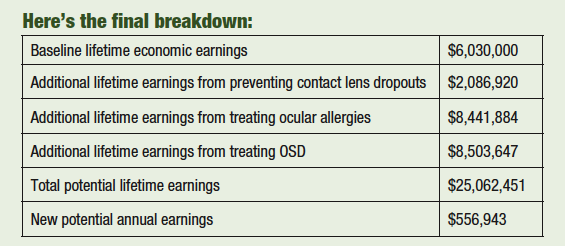
The new year is just around the corner, which means it’s almost time to make resolutions. How about concentrating on three simple things, which don’t require any additional investment, to overcome the economics of your inactions?
1. Prevent contact lens dropouts.
2. Diagnose and treat ocular allergy.
3. Diagnose and treat dry eye. Make these three simple changes and 2014 will be a good year.
Got your attention? Good. There’s more to come.
Dr. Rumpakis is the founder of Practice Resource Management, a management and consulting firm. He lectures nationally and internationally on practice management topics, as well as on managed care, contact lenses and refractive surgical procedures. He is also Clinical Coding Editor for Review’s “Coding Abstract” column.
1. American Optometric Association. State of the Optometric Profession: 2013. June 2013. Available at: www.aoa.org/Documents/news/state_of_optometry.pdf.2. Rumpakis J. New data on contact lens dropouts: An international perspective. Rev Optom. 2010 Jan;147(1):37-42 Available at: www.revoptom.com/content/d/contact_lenses_and_solutions/c/18929.

